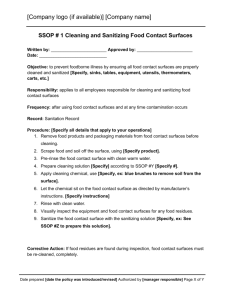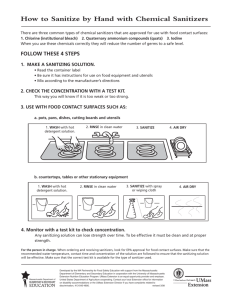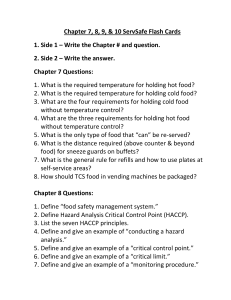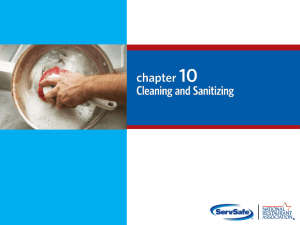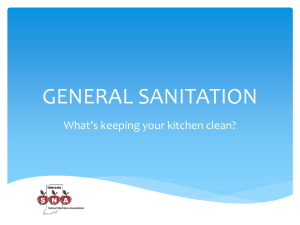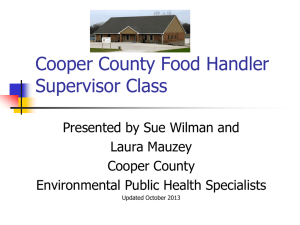ServSafe Chapters 9-10
advertisement
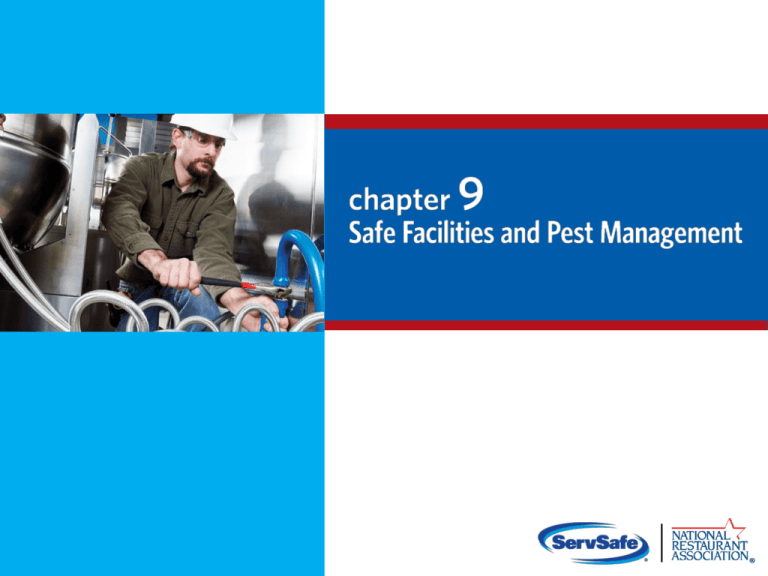
Safe Facilities and Pest Management Objectives: 9-2 Pick materials and equipment that are safe for use in foodservice operations Install and maintain equipment Avoid food safety hazards caused by utilities Maintain your facility Handle emergencies Prevent and control pests Interior Requirements for a Safe Operation Floors, walls, and ceilings: 9-3 Materials must be smooth and durable for easier cleaning Must be regularly maintained Equipment Selection Foodservice equipment must meet these standards if it will come in contact with food: 9-4 Nonabsorbent, smooth, and corrosion resistant Easy to clean Durable Resistant to damage Installing and Maintaining Equipment Floor-mounted equipment must be either: 9-5 Mounted on legs at least six inches (15 centimeters) high Sealed to a masonry base Installing and Maintaining Equipment Tabletop equipment should be either: 9-6 Mounted on legs at least four inches (10 centimeters) high Sealed to the countertop Installing and Maintaining Equipment Once equipment has been installed: 9-7 It must be maintained regularly Only qualified people should maintain it Set up a maintenance schedule with your supplier or manufacturer Check equipment regularly to make sure it is working correctly Dishwashing Machines Dishwashers must be installed: 9-8 So they are reachable and conveniently located In a way that keeps utensils, equipment, and other food-contact services from becoming contaminated Following manufacturer’s instructions Dishwashing Machines When selecting dishwashers make sure: 9-9 The detergents and sanitizers used are approved by the local regulatory authority They have the ability to measure water temperature, water pressure, and cleaning and sanitizing chemical concentration Information about the correct settings is posted on the machine Three-Compartment Sinks Purchase sinks large enough to accommodate large equipment and utensils. 9-10 Handwashing Stations Handwashing stations must be conveniently located and are required in: Restrooms or directly next to them Food-prep areas Service areas Dishwashing areas Handwashing sinks must be used only for handwashing. 9-11 Handwashing Stations Handwashing stations must have: Hot and cold running water Garbage container 9-12 Soap A way to dry hands Signage Water and Plumbing Acceptable sources of drinkable water: 9-13 Approved public water mains Regularly tested and maintained private sources Closed, portable water containers Water transport vehicles Water and Plumbing Cross-connection: 9-14 Physical link between safe water and dirty water from o Drains o Sewers o Other wastewater sources Water and Plumbing Backflow: Reverse flow of contaminants through a cross-connection into the drinkable water supply Backsiphonage: 9-15 A vacuum created in the plumbing system that sucks contaminants back into the water supply o Can occur when high water use in one area of the operation creates a vacuum o A running hose in a mop bucket can lead to backsiphonage Water and Plumbing Backflow prevention methods: Vacuum breaker 9-16 Air gap Lighting Consider the following when installing and maintaining lighting: 9-17 Different areas of the facility have different lighting intensity requirements Local jurisdictions usually require prep areas to be brighter than other areas All lights should have shatter-resistant lightbulbs or protective covers Replace burned out bulbs with correct size bulbs Ventilation Ventilation systems: 9-18 Must be cleaned and maintained to prevent grease and condensation from building up on walls and ceilings o Follow manufacturer’s recommendations o Meet local regulatory requirements Garbage Garbage: Remove from prep areas as quickly as possible o Clean the inside and outside of containers frequently o 9-19 Be careful not to contaminate food and food-contact surfaces Clean them away from food-prep and storage areas Garbage Indoor containers must be: Leak proof, waterproof, and pest proof Easy to clean Covered when not in use Designated storage areas: 9-20 Store waste and recyclables separately from food and food-contact surfaces Storage must not create a nuisance or a public health hazard Garbage Outdoor containers must: Be placed on a smooth, durable, nonabsorbent surface o 9-21 Asphalt or concrete Have tight-fitting lids Be covered at all times Have their drain plugs in place Emergencies That Affect the Facility Imminent health hazard: A significant threat or danger to health Requires immediate correction or closure to prevent injury Possible imminent health hazards: 9-22 Electrical power outages Fire Flood Sewage backups Emergencies That Affect the Facility How to respond to a crisis affecting the facility: Determine if there is a significant risk to the safety or security of your food If the risk is significant 9-23 o Stop service o Notify the local regulatory authority Decide how to correct the problem o Establish time-temperature control o Clean and sanitize surfaces o Verify water is drinkable o Reestablish physical security of the facility Pest Management Three rules of pest prevention: 1. Deny pests access to the operation 2. Deny pests food, water, and shelter 3. Work with a licensed Pest Control Operator (PCO) 9-24 Pest Prevention To keep pests from entering with deliveries: Check deliveries before they enter the operation o 9-25 Refuse shipments if pests or signs of pests (egg cases, body parts) are found Pest Prevention Make sure all of the points where pests can access the building are secure: 9-26 Screen windows and vents Seal cracks in floors and walls, and around pipes Install air curtains (also called air doors or fly fans) above or alongside doors Pest Prevention Deny pests shelter: 9-27 Throw out garbage quickly and correctly Keep containers clean and in good condition Keep outdoor containers tightly covered Clean up spills around containers immediately Store recyclables correctly o Keep recyclables in clean, pest-proof containers o Keep containers as far away from the building as regulations allow Pest Prevention Deny pests shelter: 9-28 Store food and supplies quickly and correctly o Keep them away from walls and at least six inches (15 cm) off the floor o Rotate products (FIFO) so pests cannot settle and breed Clean the operation thoroughly o Clean up food and beverage spills immediately o Clean break rooms after use o Keep cleaning tools and supplies clean and dry Pest Control Contact your PCO immediately if you see these or any other pest-related problems: 9-29 Feces Nests Damage on products, packaging, and the facility itself Review 9-17 Review What are the most important things to look for when choosing materials for floors, walls, and ceiling? 9-18 The smoothness of the materials The durability of the materials Review What standards must equipment food-contact surfaces meet in order to keep food safe? 9-19 Nonabsorbent Smooth Corrosion resistant Clean Durable Resistant to damage Review How far should floor-mounted equipment be installed from the floor? A. 0 inches B. 2 inches C. 4 inches D. 6 inches Standing mixer 9-20 Review What factors must dishwashers have the ability to measure? 9-21 Water temperature Water pressure Cleaning and sanitizing chemical concentration Review What’s missing from this handwashing station? 9-22 Review How can backflow be prevented? 9-23 Avoid creating a cross-connection Install a backflow prevention device Create an air gap Review What can be done to keep garbage from contaminating food and equipment? 9-24 Remove it from prep areas quickly Clean garbage containers frequently Purchase leak proof, waterproof, and pest proof containers Cover containers when not in use Store waste and recyclables separately from food and food-contact surfaces Make sure outdoor containers have tight-fitting lids and keep them covered Review What should be done if there is a sewer backup in the facility? 9-25 Determine if there is a significant risk to the safety or security of food o Stop service if the risk is significant o Notify the local regulatory authority Cleaning and Sanitizing Objectives: 10-2 Different methods of sanitizing and how to make sure they are effective How and when to clean and sanitize surfaces How to wash items in a dishwasher or a three-compartment sink and then store them How to use and store cleaning tools and supplies How to develop a cleaning program Cleaners Cleaners must be: Stable and noncorrosive Safe to use When using them: 10-3 Follow manufacturers’ instructions Do NOT use one type of detergent in place of another unless the intended use is the same Sanitizing Surfaces can be sanitized using: 10-4 Heat o The water must be at least 171F°(77°C) o Immerse the item for 30 seconds Chemicals o Chlorine o Iodine o Quats Sanitizing Chemical sanitizing: 10-5 Food-contact surfaces can be sanitized by either o Soaking them in a sanitizing solution o Rinsing, swabbing, or spraying them with a sanitizing solution In some cases a detergent-sanitizer blend can be used o Use it once to clean o Use it a second time to sanitize Sanitizer Effectiveness Concentration: 10-6 Sanitizers should be mixed with water to the correct concentration o Not enough sanitizer may make the solution weak and useless o Too much sanitizer may make the solution too strong, unsafe, and corrode metal Sanitizer Effectiveness Concentration: 10-7 Check concentration with a test kit o Make sure it is designed for the sanitizer used o Check the concentration often Change the solution when o It’s dirty o The concentration is too low Sanitizer Effectiveness Temperature: Follow manufacturer’s recommendations for the correct temperature Contact time: 10-8 The sanitizer must make contact with the object for a specific amount of time Minimum times differ for each sanitizer Sanitizer Effectiveness Water hardness and pH: 10-9 Find out what your water hardness and pH is from your municipality Work with your supplier to identify the correct amount of sanitizer to use Guidelines for the Effective Use of Sanitizers Chlorine Water temperature Water pH Water hardness Sanitizer concentration range Sanitizer contact time 10-10 ≥100°F (38°C) ≥75°F (24°C) ≤10 ≤8 As per manufacturer’s recommendations 50–99 ppm 50–99 ppm ≥7 sec ≥7 sec Guidelines for the Effective Use of Sanitizers Water temperature Water pH Water hardness Sanitizer concentration range Sanitizer contact time 10-11 Iodine Quats 68°F (20°C) 75°F (24°C) ≤5 or as per manufacturer’s recommendations As per manufacturer’s recommendations As per manufacturer’s recommendations ≤500 ppm or as per manufacturer’s recommendations 12.5–25 ppm As per manufacturer’s recommendations ≥30 sec ≥30 sec How and When to Clean and Sanitize How to clean and sanitize: 1. Scrape or remove food bits from the surface 2. Wash the surface 4. Sanitize the surface 10-12 3. Rinse the surface 5. Allow the surface to air-dry How and When to Clean and Sanitize Food-contact surfaces must be cleaned and sanitized: 10-13 After they are used Before working with a different type of food Any time a task was interrupted and the items may have been contaminated After four hours if the items are in constant use How and When to Clean and Sanitize Cleaning and sanitizing stationary equipment: Unplug the equipment Take the removable parts off the equipment o 10-14 Wash, rinse, and sanitize them by hand or run the parts through a dishwasher if allowed Scrape or remove food from the equipment surfaces Wash the equipment surfaces How and When to Clean and Sanitize Cleaning and sanitizing stationary equipment: Rinse the equipment surfaces with clean water Sanitize the equipment surfaces o 10-15 Make sure the sanitizer comes in contact with each surface Allow all surfaces to air-dry Put the unit back together How and When to Clean and Sanitize Clean-in-place equipment: 10-16 Equipment holding and dispensing TCS food must be cleaned and sanitized every day unless otherwise indicated by the manufacturer Check local regulatory requirements Machine Dishwashing High-temperature machines: Final sanitizing rinse must be at least 180°F (82°C) o 165°F (74°C) for stationary rack, single-temperature machines Chemical-sanitizing machines: 10-17 Clean and sanitize at much lower temperatures Follow the temperature guidelines provided by the manufacturer Dishwasher Operation Guidelines: 10-18 Clean the machine as often as needed Scrape, rinse, or soak items before washing Use the correct dish racks NEVER overload dish racks Air-dry all items Check the machine’s water temperature and pressure Manual Dishwashing Setting up a three-compartment sink: 10-19 Clean and sanitize each sink and drain board Fill the first sink with detergent and water at least 110°F (43°C) Fill the second sink with clean water Fill the third sink with water and sanitizer to the correct concentration Provide a clock with a second hand to let food handlers know how long items have been in the sanitizer Three-Compartment Sinks Steps for cleaning and sanitizing: 10-20 1. Rinse, scrape, or soak items before washing them 2. Wash items in the first sink 4. Sanitize items in the third sink 5. Air-dry items on a clean and sanitized surface 3. Rinse items in the second sink Storing Tableware and Equipment When storing clean and sanitized tableware and equipment: 10-21 Store them at least six inches (15 cm) off the floor Clean and sanitize drawers and shelves before items are stored Store glasses and cups upside down on a clean and sanitized shelf or rack Storing Tableware and Equipment When storing clean and sanitized tableware and equipment: 10-22 Store flatware and utensils with handles up Cover the food-contact surfaces of stationary equipment until ready for use Clean and sanitize trays and carts used to carry clean tableware and utensils Cleaning and Sanitizing in the Operation When cleaning the premises: 10-23 Clean nonfood-contact surfaces regularly o Includes floors, ceilings, walls, equipment exteriors, etc. o Prevents dust, dirt, food residue and other debris from building up Cleaning and Sanitizing in the Operation Cleaning up after people who get sick: Diarrhea and vomit in the operation must be cleaned up correctly o 10-24 It can carry Norovirus, which is highly contagious Correct cleanup can prevent food from becoming contaminated and keep others from getting sick Cleaning and Sanitizing in the Operation Consider the following when developing a plan for cleaning up vomit and diarrhea: 10-25 How you will contain liquid and airborne substances, and remove them from the operation How you will clean, sanitize, and disinfect surfaces When to throw away food that may have been contaminated What equipment is needed to clean up these substances, and how it will be cleaned and disinfected after use When a food handler must wear personal protective equipment Cleaning and Sanitizing in the Operation Develop a plan for cleaning up vomit and diarrhea: 10-26 How staff will be notified of the correct procedures for containing, cleaning, and disinfecting these substances How to segregate contaminated areas from other areas When staff must be restricted from working with or around food or excluded from working in the operation How sick customers will be quickly removed from the operation How the cleaning plan will be implemented Cleaning and Sanitizing in the Operation Storing cleaning tools and chemicals: Place in a separate area away from food and prep areas The storage area should have: 10-27 Good lighting so chemicals can be easily seen Utility sink for filling buckets and washing cleaning tools Floor drain for dumping dirty water Hooks for hanging cleaning tools Cleaning and Sanitizing in the Operation NEVER: 10-28 Dump mop water or other liquid waste into toilets or urinals Clean tools in sinks used for o Handwashing o Food prep o Dishwashing Using Foodservice Chemicals Chemicals: 10-29 Only purchase those approved for use in foodservice operations Store them in their original containers away from food and food-prep areas If transferring them to a new container, label it with the common name of the chemical Using Foodservice Chemicals Chemicals: 10-30 Keep MSDS for each chemical When throwing chemicals out, follow o Instructions on the label o Local regulatory requirements Developing a Cleaning Program To develop an effective cleaning program: 10-31 Create a master cleaning schedule Train your staff to follow it Monitor the program to make sure it works Developing a Cleaning Program To create a master cleaning schedule, identify: 10-32 What should be cleaned Who should clean it When it should be cleaned How it should be cleaned Developing a Cleaning Program Monitoring the cleaning program: 10-33 Supervise daily cleaning routines Check cleaning tasks against the master schedule every day Change the master schedule as needed Ask staff for input on the program Review 10-15 Review Should it be cleaned and sanitized? A. Yes B. No 10-16 Review Should it be cleaned and sanitized? A. Yes B. No 10-17 Review What are the steps for cleaning and sanitizing a prep table? 10-18 1. Scrape or remove food from the surface 2. Wash the surface 3. Rinse the surface 4. Sanitize the surface 5. Allow the surface to air-dry Review Jorge has used the same knife and cutting board to prep tomatoes for over an hour. Should he clean and sanitize them? A. Yes B. No 10-19 Review Bob finished trimming a roast and wants to use the same knife and cutting board to prep fish. Should he clean and sanitize them? A. Yes B. No 10-20 Review What two methods can be used to sanitize surfaces? 10-21 1. Heat sanitizing 2. Chemical sanitizing Review What temperature must the water be when using heat sanitizing? 10-22 At least 171°F (77°C) Review What factors influence the effectiveness of a sanitizer? 10-23 Concentration Water temperature Contact time Water hardness Water pH Review What should the temperature be for the final sanitizing rinse in a dishwashing machine? 10-24 At least 180°F (82°C) At least 165°F (74°C) for stationary rack single-temperature machines Review Are these stored correctly? A. Yes B. No 10-25 Review How should chemicals be stored? 10-26 In their original containers Away from food and prep areas Separated by spacing or partitioning
